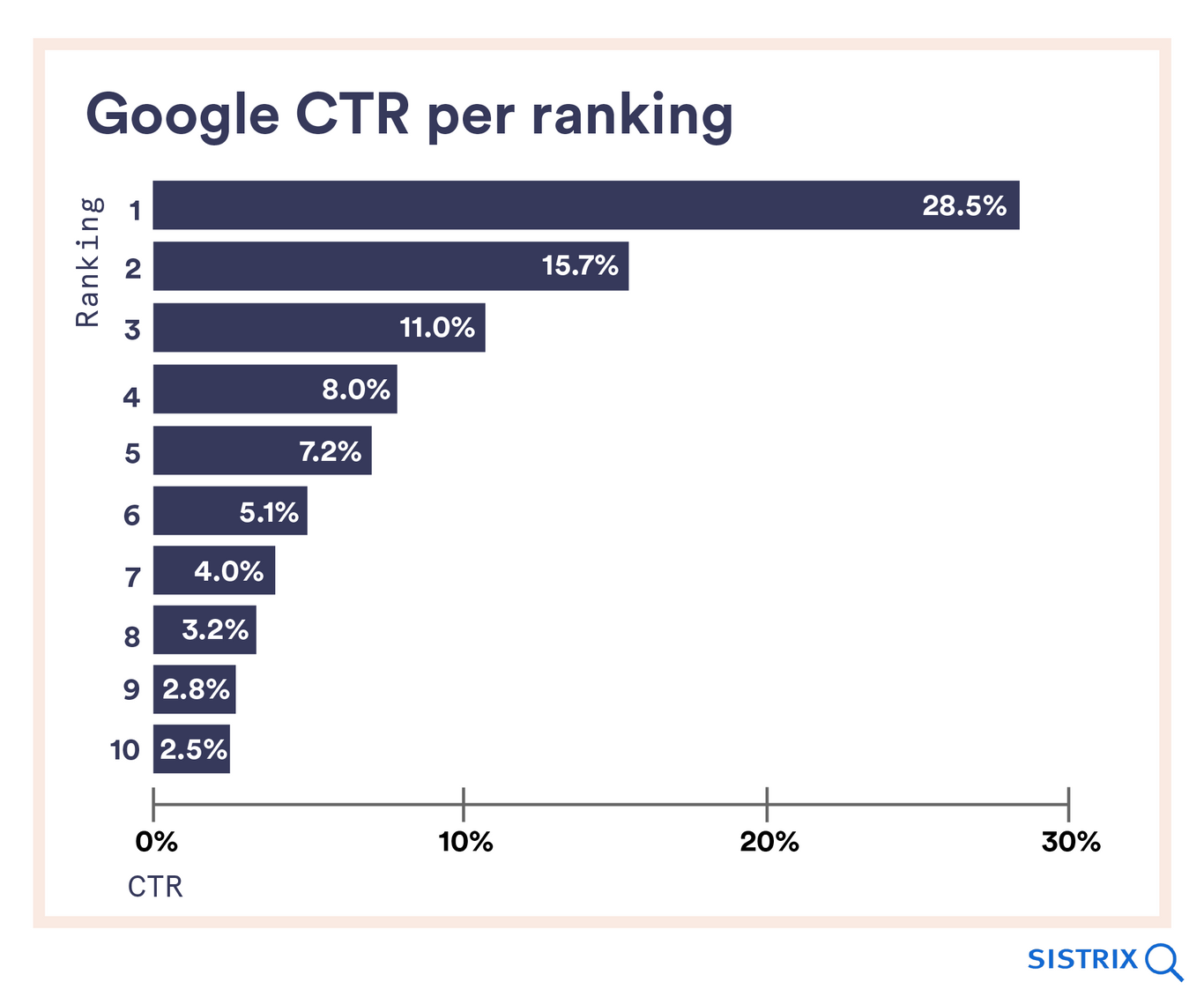SEO and Paid Media
Enterprise SEO: How to overcome the challenges and 6 tips for success
01/27/22
A strong enterprise SEO strategy can be a critical element in your marketing, helping generate more traffic, and improve visibility, authority and revenue. But, despite the value, it’s often overlooked in many companies. So, what is enterprise SEO? Do you need it? And how do you overcome the challenges it presents? Coen van der Heijden, our Nordic SEO Lead, gives his insights.
If you’re here, you're probably already aware of just how important search engine ranking is for your brand visibility and to get visitors to your website. After all, despite there being approximately 2 trillion global search queries every year on Google, around 90% of pages get zero traffic from the popular search engine.
Not only that, but around one-third of clicks in Google search results (28.5% according to 2020 research by Sistrix) go to the top-ranking result, and 88% of clicks go to the first page. Ensuring your pages are ranking high really pays. So how do you get to those prized top spots? That’s where Search Engine Optimization (SEO) comes in.

There are many ways to improve your ranking – from optimizing your content for certain keywords and reducing the number of technical errors on your site, to acquiring more backlinks from other reliable websites.
But when your website spans thousands, or even millions, of pages including legacy content that hasn’t been updated (or even looked at) in years, improving your SEO can be an extremely daunting prospect. But fear not – enterprise SEO is here to help.
What is enterprise SEO?
While there’s no hard and fast definition for enterprise SEO, the key differentiator generally comes down to scale. Sites or companies needing to work on enterprise SEO have larger-scale and more complex needs. It can mean that the companies themselves are bigger – but not always. Sometimes it’s the number of pages that they’re dealing with - from several thousand up to millions of pages, or the complexity of the company and the number of stakeholders that you're dealing with.
For example, a relatively new e-commerce business might be a fairly small business but have tens of thousands of pages. And for them, the visibility and performance of their website are critical for the success of their business. They would certainly benefit from a strong enterprise SEO strategy in place – and may even have a whole team working to achieve and deliver it.
A large international organization, on the other hand, may not have as many pages on its website, but it may have large teams of people around the globe producing, updating, and editing its content. Enterprise SEO would also be important for them to maintain consistency and ensure their website and brand visibility are performing to the level they need.
While the main SEO pillars - content, technical factors, and links - remain the same as in regular SEO, the focus is really about looking at new ways of working that can support a larger group of people, and a larger number of pages, to deliver effective SEO and ensure these pillars are upheld.
The three main challenges in enterprise SEO – and how to overcome them
The ideal users for enterprise SEO may look (and be) very different – but they all share some element of scale or complexity. And with size and complexity, come challenges. So, what are the main challenges facing these companies? And how can enterprise SEO help?
Enterprise SEO Challenge 1: The shift to data-driven content
Perhaps the most difficult challenge we face in enterprise SEO is in getting clients to embrace an outside-in approach or customer-centric perspective. In these companies and their marketing efforts, the focus is often on the products rather than on the needs and behavior of their target audience. How and where are customers searching for these products or services? The answers are available – they’re right there in the search data. So, if you want to optimize your brand visibility and reach, your focus should be on the data – then you can build your SEO (and content) strategy around that.
A really good starting point is to look at your existing content and try to understand whether this is information your target audience is actively searching for (pulling on, in SEO terms) or, if not, that this is information you’re pushing towards them. This can help you work out how (and if) to optimize certain pages, and also what channels and audiences the content is best suited to. It provides a really good foundation to help a company work better internally and activate the right content, in the right channels, for the right people. After all, better targeting equals better results.
Competing content is also a huge issue and one we see a lot of in enterprise SEO. In fact, many companies are not even aware that they're competing with themselves in search results. So auditing for this, and having an overview or map of your content with responsibility assigned for each keyword or topic is essential to ensure you’re not self-sabotaging your SEO, and limiting your visibility and reach.
Of course, many companies aren’t at the level of digital maturity to have a data-driven approach to content production and optimization yet, so this is usually the first area where we step in to help our clients. To make sure the data is available, useful, and informative for the people that actually work on the site and content, we need to structure both the data and processes in a way that makes it as simple as possible for them to improve the performance of their pages. And this structure can present a huge challenge in itself.
Enterprise SEO Challenge 2: Building a structure that works
Because you’re often talking about large-scale or complex needs, you’re also talking about many stakeholders involved. There may be marketing staff, content producers, web editors, IT, management – sometimes even large teams in different regions across the globe controlling and publishing content. Essentially, there may be a lot of people with access to the functions that impact a website, people who are likely on several levels, and that have different responsibilities – and their own priorities.
When you develop an enterprise SEO plan or strategy, an integral part will be working out how best to manage all these stakeholders and the content in a consistent and structured way. It's all about understanding how a company works, then trying to find a process that fits their needs, while also looking after their SEO needs. It means building a set of rules and regulations – a governance structure that everyone can rely on.
Remember, the ultimate goal is to improve search visibility and reach your target audience via search. To achieve this, you need to create the right foundation. A good structure will keep everyone involved informed and on the same page, focused on the right elements – the right type of pages, the right metrics. It will also ensure that the information is gathered, collated efficiently, and delivered to the right people. Which leads us straight to our next challenge.
Enterprise SEO Challenge 3: Making things more efficient
Within a smaller SEO project, pulling data manually or on an ad hoc basis can be perfectly manageable. But when you're dealing with an enormous amount of pages, or a lot of stakeholders, it won’t work. This is when you need to look into automated solutions.
Fortunately, once you’ve overcome the challenge above and have a strong structure in place, you’ll have a clear roadmap detailing what the processes and goals are, what metrics you’re using and data you need to collect, and the stakeholders and who is responsible for what. From there it’s just about finding the right automation tools or solutions that best meet your needs, gathering all the necessary information, and communicating it to the right people.
So, are you ready to get started on an enterprise SEO plan or strategy for your company? Here are some pro tips to keep in mind!
Six tips for successful enterprise SEO
Tip 1: Start with what you’ve got
It’s not always feasible (or necessary) to start over from scratch, completely restructure or develop a huge amount of new content overnight. Start by reviewing and improving performance on the pages and content you have.
Tip 2: Not everything has to perform in search
Not everything has to, or even has the potential to, perform in search. Identify what does and focus on optimizing that to reach your target audiences and improve conversion, while considering what channels are best to promote and share your push content to relevant audiences.
Tip 3: Don’t overlook keyword governance
Prevent self-competition and smooth operation with keyword governance. Assign who will be responsible for specific website sections or pages, and ensure the content is directing people to the right place for the information they are searching for.
Tip 4: Make the switch to data-driven content
To increase rankings, reach and visibility, focus on data-driven content – conduct keyword research and use an outside-in approach, based on what customers are searching for. Don't forget to consider non-branded searches. Optimizing for your product name or brand will only bring traffic from those who already know of your product names or brand. Is that what you want? Understand and quantify search behavior. Then research the user's search intent and aim for creating the most relevant content possible for their query.
Tip 5: Measure your performance
As with any strategy, it’s vital to clearly outline your goals and key performance indicators (KPIs). Depending on what you’re trying to achieve, these might include ranking positions, organic traffic, and quality metrics such as bounce rates, page views, and time on page (to ensure your content is relevant and useful to your target audience) as well as technical SEO metrics like a number of indexed pages and crawl errors. And don’t forget conversion metrics such as sales, downloads, or contacts. After all, the ultimate point of driving traffic is to get those people to take the step from website visitors to customers, so keep an eye on if your content is delivering the results you need to make that happen.
Tip 6: Learn, change, grow, repeat
Enterprise SEO can be a complex area to work on. There’s a lot to consider, and the technical factors for successful SEO often evolve over time as search engine prioritization and ranking criteria change. To stay ahead of the game, be sure to build your (or your team’s) knowledge and develop your company’s digital and SEO maturity with ongoing training.
Still confused, or need help getting started with your enterprise SEO? Contact us today to explore how our team of experts can assist you.



